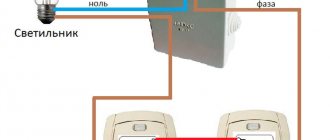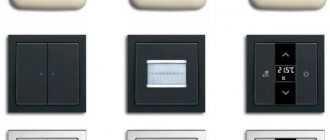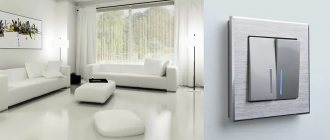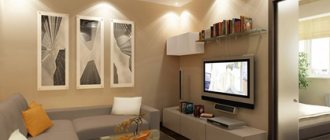Wireless light switch is a multifunctional accessory for controlling home lighting. It turns the lighting on/off by sending a signal “over the air” to a receiver or relay. To install such a device, you do not need to lay many meters of wiring and ditch walls, and it can be placed in any convenient place (within the reach of actuators).
What is a wireless switch for?
Remote systems that provide control of certain devices at a distance are becoming increasingly widespread. The wireless wall switch is no exception.
It was created to increase comfort, and for senior citizens and people with disabilities it is absolutely necessary.
Using such a device, you can easily control the lighting in your home, change the brightness, turn lamps on and off.
In addition, thanks to the special design, there is no need to damage the walls or make large holes for installation.
Correct connection
In order to properly mount the switch, you need to know its operating principle, what the device consists of, and how to connect the Wi-fi switch. The connection diagram for this wireless device is very simple.
One of the advantages of a Wi-Fi light switch is its ease of use and connection. If you really want to, you can install the device yourself
It is important to strictly follow the instructions provided by the manufacturer. This installation takes only a few minutes
The connection process consists of only two stages:
- Installing a radio receiver.
- Installation of a light switch (control button).
Basically, receivers have from two to four wires. They come out of the device body. To determine the input wire, you must read the instructions. The remaining wires will be output wires, for example, a double switch will have two outputs. To install the receiver, you must open the phase that supplies power to the lighting device and connect it to the circuit, while observing the sequence.
In the case where it is necessary to connect more than one lighting group, proceed as follows:
- zero is supplied to all lighting fixtures;
- the phase is branched in the Wi-fi switch;
- the phase should be supplied separately to each group of lamps.
The control button is installed quite simply; first you need to make a hole in the wall using a hammer drill with a concrete cutter. A regular plastic socket box is inserted into the finished hole, and plaster can be used to secure it. The installation process is absolutely no different from installing a key-type light switch. The only difference is that there is no need to lay wires, you just need to securely fasten the button in the socket.
Finally, we recommend watching a video that clearly shows how to connect a Wi-fi light switch:
Now you know what a Wi-fi light switch is and how lighting is controlled via a smartphone. Wireless electrical accessories are becoming increasingly popular, so if you decide to implement a Smart Home system, we advise you to acquire the devices we have reviewed.
It will be useful to read:
- How does a Wi-Fi socket work?
- Remote lighting control systems
- Heated floor control systems
Scope of application
Traditional switches are gradually becoming a thing of the past due to inconvenience of use, complexity of connection and installation, as well as a small resource. Wireless analogues have better qualities.
They have a stylish appearance and install within a few minutes.
The use of such products is relevant in the following cases:
- When moving an old switch, when pieces of furniture interfere with its installation. The new device can be mounted anywhere in the room - on a wall, mirror, cabinet or other element of the room.
- To eliminate electrical errors. When installing wiring, mistakes are often made that affect the comfort of living in an apartment or house. In such cases, it is not necessary to make a strobe or plan expensive repairs - you can install a wireless switch (with or without a remote control).
- When there is a shortage of space. The classic option is that it is difficult to install the switch on a cabinet or other piece of furniture due to the complexity of the mounting. Wireless analogues are overhead, and their installation is accessible even to beginners. In addition, during the installation process there is no need to lay the cable and worry about its disguise. And the radio switch can be placed anywhere, be it a coffee table, bar counter, bedside table or other piece of furniture.
- In wooden houses. The advantage of buildings made using wooden materials is undeniable. They are distinguished by their durability, ability to retain heat, and also low price. But when installing wiring, problems arise due to increased safety requirements. The best option is to install open wiring, but it spoils the appearance of the interior and is susceptible to mechanical damage (including from rodents). Making hidden wiring in a wooden house is quite a problem. The best solution is to install wireless light switches, which simplify the process of installing hidden wiring and save money.
- To control lighting from multiple locations. There are situations when turning on the light needs to be done from 2-3 parts of the room. To avoid running wires to each switch, it is better to use wireless devices. With their help, lighting control is simplified and installation time is reduced. If desired, you can install wireless switches with a remote control.
- If necessary, install additional switches. It happens that after completion of the repair work the chosen location is not satisfactory and the installation of an additional device to control the light is required. Installing a wireless switch solves the problem.
- To turn lights on/off over long distances. What to do in a situation where you need to turn the lamp on and off from another room or even from the street? Running a wire to install an additional switch is expensive and unsafe, but new technology allows you to avoid such problems. The peculiarity of radio switches is their large operating range - up to 350 m (depending on the model). Control can be done using a simple remote control, which for convenience is made in the form of a key fob.
- In order to preserve the design of the room. If installing a switch in a recess is not possible, you have to install overhead types of products that spoil the appearance of the room and do not look very solid. The solution to the problem is to install a wireless device that is thin and fits perfectly into the interior.
- As an alternative to conventional devices. During the next renovation of an apartment or house, you want to introduce some innovations into the design and make life more comfortable. One way is to install a wireless remote switch. Such products will cost more, but they are easy to install, have a solid appearance and provide ease of lighting control.
Where are they used?
Wireless switches are used wherever it is necessary to install a new or move an old switching device, but due to some circumstances it is impossible to get by with classic wired options.
In difficult situations, it is possible to install such a gadget not only on the wall, but also, for example, inside a closet shelf, on a mirror, and so on. This does not affect functionality - the device will continue to function normally. This will help save space and not worry about the aesthetic side if, for example, the purchased accessory turns out to not match the overall style of the room. You can simply hide it.
A remote light switch will also come in handy in case of errors with the wiring. Now you don’t have to re-arrange everything, just place the “over-the-air” model in a convenient place, and the problem will be solved.
This class of accessories is gaining popularity in the field of wooden construction. Wiring in a wooden house requires special fire safety measures, and wireless devices help reduce the number of potentially dangerous cables. In addition, in the case of open wiring, the latter is more vulnerable to damage, and wireless-type modules largely eliminate the likelihood of breaks, short circuits and other troubles. Although the remaining wired communications still require protection measures.
An “air” switch will be a real salvation in houses with many rooms or rooms divided into locations with separate types of lighting. You don’t need to install many separate devices—it’s enough to get by with one or two (for example, multi-key devices) and associate them with the necessary lighting fixtures, and then activate the necessary segments as needed.
Another use case for wireless light switches is in renovated spaces. When the renovation is completed and the final coating has been applied to the walls (be it laminate, wallpaper, paint or something else), it can be difficult to add any functional electrical wiring components to the decor. Including the switch - this requires dismantling the finishing, gating and other manipulations. A wireless switch solves this problem - you just need to place it in the right place with a minimum of time and effort, and without harming the new interior.
The same applies to premises with historical value, where large-scale interventions and changes to the situation cannot be carried out. Remote switches can easily be “disguised” into furniture and objects and provide comfortable control of the lighting level.
You cannot do without a modern lighting control system in large commercial premises, conference rooms and other places with large areas. It will make it possible to turn on the lights throughout the entire territory from one device, including while outside the building. The same system allows you to track your status, and the most advanced models even have the function of counting the kilowatts spent.
Varieties
Wireless switches are not very diverse, but there is still a certain selection.
They are classified according to three main characteristics:
- By type of control;
- If possible, regulate the level of illumination;
- By the number of lighting devices they control.
Taking into account the classification mentioned above, the following types of wireless switches can be distinguished:
- With a delay function to ensure the lamp stays on for a certain amount of time. This option allows, for example, to walk to the bed while the light is on, after which the room is plunged into darkness.
- With the ability to configure multiple channels. In this case, it is possible to turn on several products simultaneously.
- Sensory. To turn the lighting on/off, just touch the panel.
- Wireless (with the ability to control over a Wi-Fi network) or radio controlled.
Components of the wireless module
The design of a wireless switch is very simple and consists of two working components: a receiver and a transmitter. Each of these nodes has its own area of responsibility and performs strictly defined functions that ensure correct control of the lighting system.
Design and principle of operation of the receiver
The receiver is a radio-controlled relay, which during operation picks up the corresponding signal and closes the galvanic circuit of household electrical wiring.
The relay is placed as close as possible to the lighting fixture, or somewhere in the neighborhood, but always in a place that falls within the coverage area of the transmitter.
Due to the compactness of the receiving radio relay, it can be placed in a chandelier, sconce or floor lamp. When you want to take control of the control of spotlights, it is appropriate to “hide” the receiver behind the suspended ceiling
Another option is to mount the element into a distribution box, if its dimensions allow this to be done technically. The mini-device is controlled from a remote control, smartphone, tablet, computer via Wi-Fi or radio waves.
Specifics of the transmitter operation
For correct operation, the transmitter does not need to be connected to an active power supply. Power is provided by autonomous energy sources - batteries.
More advanced models have a small internal generator that generates electric current when the user presses a key. The energy pulse that occurs at this time is transformed into a radio signal, which is picked up by the receiving device.
Commands to the module are given from the remote control or via a phone with access to Wi-Fi. In this way it is possible to control up to 8 devices simultaneously
A signal transmitter equipped with an energy generator is more expensive than a similar battery-powered model. But the price is quickly compensated by the ease of use, and the owners do not have to think every time about how not to forget and replace worn-out batteries in a timely manner.
The coverage area of a device depends on many parameters. This is primarily influenced by the general technical characteristics of the product and the structural features of the room (layout, presence of furniture, false walls, etc.) where the module is located.
Simple budget devices transmit the correct signal within a radius of 20-50 meters. In more advanced models, this figure reaches 350 meters, but the price for such powerful devices is still high.
The signal transmitter, operating on rechargeable batteries, does an excellent job of turning on and off the lights in rooms, serves for a long time and requires only one thing from the owners - timely recharging of the batteries using a charger
Some manufacturers produce products with expanded functionality. “Smart” devices take on not only the standard control of turning on/off light bulbs, but also regulate the intensity of lighting devices and the degree of illumination of the room. This mode is ensured by a special component – a dimmer.
The device, equipped with a dimmer, allows you to set the most convenient level of luminous flux saturation. This action is carried out by holding or scrolling the operating button located on the switch itself
The purpose of the dimmer is to regulate the electrical power responsible for the brightness of the light. The device works normally with both LED and traditional incandescent lamps.
Design and principle of operation of the main elements of the device
The wireless switch consists of the following elements:
- The receiver is a special radio relay that is controlled by a remote control, using a phone with access to Wi-Fi, or directly from a switch. After receiving the signal, the relay closes or opens the contacts. The product is mounted as close as possible to the light source or inside it (if the appropriate dimensions are available).
If we are talking about a spotlight, installation is carried out in a junction box or in the cavity between the main ceiling and the tension fabric. - Transmitter (switch). This device includes a small generator that generates electricity when you press a remote control button, touch a switch, or send a signal from your phone (when controlled via Wi-Fi). The electrical impulse is converted into a radio signal, which is picked up by the receiver. The transmitter can be installed directly into the wall. In this case, there is no need to connect wires to it, because power is supplied from the built-in elements. Thanks to this feature, you can save time on installation and not open the walls. In this way, a transition switch is made that allows you to control the lighting from different points and not have to look for the remote control.
Connecting and binding (programming) a remote switch
As mentioned earlier, connecting the 220V power wires and the output wires to the light bulb in the radio module can be done directly in the junction box, if space allows. Or in the lamp itself under the ceiling.
Moreover, the main thing is to connect zero and phase to the input, and sometimes it is enough to connect only a phase conductor to the output (zero goes directly).
When you first apply voltage, nothing may happen, no matter how many times you press the key. Because there is no connection. In order to program a remote switch to the receiver module, perform the following operations:
- press the central button on the radio module and wait until the LED starts blinking quickly
- at this moment, gently press the key
If the binding is correct, after pressing the key, a characteristic click of the switch will be heard. The LED in the box will be constantly on. Next press will turn off.
In order to add a second one to the circuit, follow the same procedure as with the first one. Press the button again, wait until the diode starts flashing quickly and press switch No. 2.
After configuration and programming, their operating principle will be the same as that of ordinary pass-through switches.
The same lamp can be turned on and off from completely different and remote places.
At the same time, you get rid of a bunch of extra wires, junction boxes, gating work and subsequent plastering and finishing of walls and ceilings. And all this for just 800 rubles!
The same binding can be done with three, four or more switches, a remote control or a remote control.
To untie and erase the connection with the switches from the receiver’s memory, just hold down the setting button for more than 5 seconds. As soon as the LED starts blinking slowly, release the button. The device will be deprogrammed.
Advantages and disadvantages of wireless switches
Despite their ease of use, wireless load switches (in our case, lighting) have not only advantages, but also disadvantages. But more about everything.
Pros:
- Ease of installation. For installation and connection, you do not need to drill into walls or lay a separate “branch” of electrical wiring.
- Possibility to control several light sources at once from the remote control or via a smartphone.
- Large range of action. The control signal in an open area can reach the receiver at a distance of up to 30 meters. In this case, walls or pieces of furniture are not an obstacle.
- Safety for adults and children. Even accidental damage to the structure does not pose a health risk. The operating current in wireless remote switches is minimal and not hazardous to health.
Minuses:
- The cost of such products is higher than classic “wired” switches. Adherents of economy and conservatives prefer familiar products.
- Inability to control due to low battery in the remote control or inability to control due to weak Wi-Fi connection.
Remote switch design
The switch is very easy to disassemble. It is enough to use a screwdriver to pry out the slots at the junction of the cover and the body. There is no need to unscrew any screws.
Inside it is:
- electronic board
- central on/off button
- LED for visualizing the connection between the switch and the radio module
- battery type 27A 12 volt
This battery, even with intensive use, can last 2 years or more. In addition, there is no particular shortage of them at the moment. It may not be included in the package, please keep in mind.
By the way, the switch is initially universal. On the sides of the central button, there are places where you can solder two additional buttons.
And by changing the key itself, you can easily change from a single-key to a two- or even three-key one.
True, in this case you will have to add more modules, according to the number of buttons.
There is a hole on the radio module box. It is intended for a button, when clicked, you can “bind” or “erase the binding” of a particular device.
In terms of radio signal range, the manufacturer claims a distance from 20 to 100 meters. But this applies more to open spaces. From practice, we can say that in a panel house the signal easily penetrates four concrete walls at a distance of 15-20 meters.
There is a 5A fuse installed inside the box. Although the manufacturer indicates that through a remote switch you can connect a load of 10A, which is as much as 2kW!
The diagram for connecting wires to the contacts of the radio module of the wireless switch is as follows:
When connecting, you can also navigate by the labels. Where there are three terminals there is an output, where there are two terminals there is an input.
- L out – phase output
- N out – zero output
Connect the wiring to the light bulb to these contacts. Supply voltage 220V to the two contacts on the other side.
On the side of the output contacts there are three more points for soldering jumpers. By re-soldering them accordingly (as in the figure), you can change the logic of the product:
When the key is pressed, the relay contacts close. When released it will turn off.
This can be used to make a call or to give a short-term signal of some kind. There is also a middle contact “B”. When using it, the switch will operate in inverse mode.
Characteristics you should pay attention to when choosing
When purchasing a wireless remote switch, you should pay attention to the following parameters:
- The type of light bulbs the device controls;
- Material, color and appearance of the case;
- Operating voltage;
- Number of channels;
- Radius of action;
- Maximum load;
- Dimensions;
- Rated current;
- Equipment.
It is also worth paying attention to the following criteria:
- Operating frequency range;
- Signal transmission method;
- Availability of encoding;
- Transmitter power type;
- Estimated battery replacement time;
- Fastening method;
- Operating temperature range;
- Price.
What to look for during the selection process
Before you begin selecting a wireless switch, you should determine the number of lamp groups that the device will serve. The number of channels can vary from one to eight. Low power consumption of touch and button products in gentle standby mode guarantees long-term operation of the transmitter: battery replacement is not required for two to seven years.
Additionally, it is necessary to calculate the total power of the light sources planned for connection, then accordingly select a device with optimal technical characteristics. It is definitely worth considering that models using infrared rays operate only at a viewing distance of the receiver; at the same time, radio waves can bend around all sorts of obstacles and penetrate walls inside structures. For a private home, there is no need to purchase a transmitter with a maximum power of 10 mW and a range of 0.1 km. In this case, a distance of 30 meters will be sufficient.
What does the market offer?
A wide range of wireless remote switches allows you to choose a product based on price, characteristics and appearance.
Below we consider just a few models that the market offers:
- Fenon TM-75 is a remote-controlled switch made of plastic and designed for a voltage of 220 V. The features of the device include the presence of two channels, a 30-meter range, the presence of a remote control and a delay switch function.
A group of lighting fixtures can be connected to each channel and controlled. The Fenon TM-75 wireless switch can be used with chandeliers, spotlights, LED and track lights, as well as other devices operating on 220 Volts. - Inted 220V is a wireless radio switch designed for wall mounting. It has one key and is installed in conjunction with the receiving unit. The operating voltage of the product is 220 Volts, and the range is 10-50 meters. The wireless light switch is attached using self-tapping screws or double-sided tape. The body is made of plastic.
- INTED-1-CH is a light switch with remote control. With this model you can control light sources remotely. The power of the lamps can be up to 900 W, and the operating voltage of the product is 220 V. Using a radio switch, you can control the equipment, turn on and off the lights or alarms. The product is based on a receiver and transmitter. The latter has the form of a key fob, which is small in size and transmits a signal over a distance of up to 100 m. The product body is not protected from moisture, so additional protection must be provided when installing outdoors.
- Wireless touch switch controlled via remote control. The product is mounted on the wall, has small dimensions and is made of tempered glass and PVC. The operating voltage is from 110 to 220V, and the rated power is up to 300 W. The package includes a switch, remote control and bolts for attaching the accessory. The average life cycle is 1000 clicks.
- Inted 220V 2 Receiver - Wireless Light Switch for Wall Mounting. Control is carried out using two keys. The body is made of plastic. The operating voltage is 220 V. The number of independent channels is 2.
- BAS-IP SH-74 is a wireless radio switch with two independent channels. Control is carried out using a mobile phone on the Android operating system. To work, you must install the BAS application. The SH-74 model is used to control incandescent lamps with a power of up to 500 W, as well as fluorescent light bulbs (power limit - 200 W).
- Feron TM72 is a wireless switch that controls lighting at a distance of up to 30 meters. The light sources are combined into a receiving unit, and switching on and off is done using the remote control. The TM72 model has two channels, each of which can be connected to a specific group of devices. The product has a large power reserve per channel (up to 1 kW), which allows you to connect different types of light sources. The big advantage of the model is the presence of a delay ranging from 10 to 60 seconds.
- Wireless 3-channel switch 220V Smartbuy is designed for connecting light sources into three channels with a power limit of up to 280 W. The rated supply voltage is 220 V. Control is carried out from the remote control, which has a range of 30 meters.
- Z-Wave CH-408 is a wall-type radio switch that allows you to program various scenarios for controlling lighting devices. If necessary, up to eight switches can be connected to it. Among the additional features, it is worth highlighting the management of Z-Wave devices (up to 80) and ease of configuration regardless of the main controller. The device is powered by two batteries, and when they are low, a corresponding signal is given. Firmware updates are performed via the Z-Wave network. The maximum distance to the controller should not exceed 75 meters. Protection class - IP-30.
- Feron TM-76 is a wireless light switch that is controlled remotely using a radio signal. The receiver connects to light sources, and the remote control controls the receiving unit at a distance of up to 30 meters. The Feron TM-76 model has three independent channels, each of which can be connected to its own group of lighting fixtures. In this case, control will be carried out separately, using the remote control. The maximum power reserve is up to 1 kW, which allows you to connect various types of lamps (including incandescent). The operating voltage is 220 V.
Review of popular DV models
Similar electrical equipment is produced by manufacturers from different countries.
Popular Wookee radio switches
Remote devices produced by this company consist of a kit that includes a radio signal receiving unit and a remote control. For comfortable use, the set also includes a holder. Specially made holes on it make it easy to attach this part to a vertical surface using ordinary self-tapping screws.
The models are equipped with two switches, thanks to which the devices can operate with different electrical networks. The maximum load in each can reach 500 W. The operating radius of the device is 100 meters in open space and 20 meters indoors. In order for the device to work correctly, it is recommended to install it together with the relay in the junction box.
"Nootechnics" - based on infrared waves
A well-known Belarusian company produces a line of switches with remote control based on infrared radiation “Sapphire”. The models presented in the series are made of high quality polymers, predominantly white in color.
Remote switches of the Sapphire brand are produced in a wide range. Their action is based on the principle of exposure to infrared radiation. Models differ in both design and technical characteristics
The products are equipped with dimmers that allow you to regulate the power of the energy flow, which extends the life of the lamps. The parameters set during the last switch-on are saved when the device is started again, and this reduces the time for selecting the desired brightness parameter.
Many models provide a function to simulate the presence of the owner in the house, associated with periodic turning off/on of lamps in the house. The disadvantages of the models from this company include low-sensitivity sensors, which makes manual control difficult: for correct operation, all manipulations must be performed with the palm of your hand.
German quality and Jung brand design
The well-known German company producing electrical products pays attention to both high-quality mechanisms and impeccable design.
Models of remote light switches produced at the enterprises of this company have a standard set of functions, high build quality, and the use of first-class parts and components. A wide range of variously designed products allows you to choose a model that will fit perfectly into the most sophisticated interior.
The company's catalog includes a line of anthracite appliances (with black polished surfaces), bright models made of acrylic and colored glass, universal products of traditional shapes made of steel and aluminum, and affordable devices made of plastic.
A separate series includes devices with moisture protection, which are intended for use in rooms with a high content of water vapor, for example, in bathrooms.
Practical models "Master Kit"
The most popular devices of this brand are remote switches MK343 and MK344. The first option allows you to remotely switch over two independent radio channels (the permissible power of each is 300 W).
Moreover, if the power unit is equipped with a radiator, the device can withstand a power of 1000 W. To control the device, a keychain transmitter equipped with four buttons is used.
A more advanced modification is the MK344 model, which provides not only on/off, but also smooth adjustment of light intensity through two separate channels.
All functions can be performed using 4 buttons on the remote control: two of them are used to supply the load, and the remaining two are used to control the brightness of the lamps.
Compact and easy to use SOSO
The company specializes in producing small wireless switches. Such devices, capable of operating at high power (up to 3.5 kW), can be placed in a mounting box behind a power switch or socket.
A compact remote device having the size and shape of a regular lamp. The original configuration allows you to place the device in a regular chandelier socket. No wiring required
The power unit in this case is mounted as follows. Having selected the appropriate load indicator, you must turn off the power to the network. Similar to a conventional switch, a power unit is installed, which must be connected to phase and neutral.
The diagram shows the installation of the SOSO ACM-1000 radio switch in the installation box. The wires are connected using terminal blocks; twisting is not recommended
The mains phase wire (brown) passes through the terminal block and is supplied to the L-terminal of the power block, while the zero wire is attached to terminal N. The socket, in turn, is connected to the block output terminals N and L, after which the device can be installed on it .
It is also important to activate the command memory mode, for which you need to press the corresponding button. After this, you need to send a signal from the radio remote control. An indicator of storing this information is the LED blinking twice.
The following article, which is entirely devoted to this interesting issue, will introduce you to the rules and guidelines for choosing a wireless light switch.
Connecting switches
There is nothing complicated about connecting remote switches. If you wish, you can easily install the device yourself. The receiver has two or four wires coming out of it, depending on how many groups of lights it controls.
One of the wires is the input, the others are the output. To install such a device, the master needs to break the phase that supplies power to the lighting device, and simply connect it in series to the circuit.
When a wireless device is installed, everything becomes even easier. There are no wires needed here at all, the master simply attaches the button to the box, and you’re done. As you can see, it's not all that complicated. To install remote switches, in-depth knowledge of electrical engineering is not required. You just need to know a little about the flow of current in a circuit.
Advantages and disadvantages of remote control devices
Devices that allow you to control lighting using a remote control have certain pros and cons. The most important advantage is the ease of installation and ease of connection: installation of the device does not require special knowledge.
The ease of use and the ability to smoothly adjust the lighting fixtures attract attention. Some models also have a device programming function, with which you can set the “presence effect”
In this case, the device will turn on/off automatically at a certain time, which can be useful if the apartment is empty.
As a rule, manufacturers produce a set of equipment necessary to enable remote adjustment of lighting fixtures. The power unit must be connected to an existing electrical network
The use of remote control devices helps reduce electricity consumption, as well as extend the service life of various types of lamps. In addition, the remote switch makes it possible to simultaneously control several light sources or even other devices from one remote control.
The disadvantages of such devices include the occasional false or spontaneous operation; a weak radio signal that may not pass through an obstacle; possible effects on pacemakers or hearing aids.
Switches located outdoors may not operate correctly due to precipitation. In addition, the batteries on the control panel may run out at the most inopportune moment.
Remote control system for light in an apartment
Light control scheme via the Internet
Light control in an apartment can be carried out by switches with a range of up to 100 m or less, depending on the area of the room. If there are load-bearing walls or iron reinforcement in the walls along the signal path, there are radio signal repeaters that allow you to bypass obstacles and increase the power of the transmitting device.
You can install 2 light control systems in your apartment:
- Local, if one lighting source is connected to one switch.
- Global. In this case, all lamps and spot groups will be connected to a single control panel. The scheme may include air conditioners, ventilation systems and other electrical devices, for example, automatic blinds or roller shutters.
In large apartments it is possible to combine the operation of sensors and a remote switch. This is necessary for temporary lighting of passage areas. The sensor is installed in the direction of travel and is triggered if a person enters a certain area, then turns off.
The device can operate in several modes:
- Temporary. When you press the button, the light turns on for a certain time, then goes out on its own.
- On/Off. When the button is pressed once, the devices are either turned on or off.
- In monostable mode, holding down the button will keep the light on. If you let go, it will go out.
- Bistable mode is a cyclic change in the operating state of the device.
The more modes, the more expensive the equipment.
Operating principle and design
Receiver and Remote Switch
Structurally, the remote lighting switching device consists of a receiver and a signal transmitter.
More details about these devices:
- Receiver. The element is made in the form of a radio relay controlled via a remote control. You can turn the light off and on from a mobile device connected to a Wi-Fi network, as well as from a wired switch. As a result of receiving a signal, the relay is activated and closes the contact elements or opens them. It is advisable to install the device in close proximity to the lighting fixture or inside it, if dimensions allow. In the case of spotlights, the device must be installed in the distribution panel or in the free space between the suspended and main ceilings.
- Transmitter or remote control. The device structurally consists of a generator that generates electricity after activating a button on the remote control. Generation occurs after touching the sensor or transmitting signals from a mobile gadget. Electrically, the signal is converted into a radio pulse, which is picked up by the receiver. The transmitter can be installed in the wall or not installed at all, but carried with you. There is a power source inside the remote control, so there is no need to connect it to an electrical line.
Infrared control
Lighting devices are controlled by exposure to infrared radiation. To do this, the processor control module must be connected to the lighting circuit break. The action can be performed using the TV remote control. The device is pointed at the processor module, after which a button is pressed, which does not switch television channels. This leads to commands being written to the device’s memory, and then the lighting is controlled from the pressed key. The main disadvantage of this control method is the need to ensure line of sight at a short distance.
Radio wave control
This control option is more common. Signals are transmitted to the radio switch from the remote control to the processor module. which is tuned to operate in a specific frequency range. Packet data is exchanged using special codes. High reliability of signal transmission from the remote control to the radio switch itself is ensured by creating the required level of pulses and repeating them in a certain sequence. The signals are repeated several times. To prevent a situation where the lighting is triggered by a neighbor's remote control, each switch is assigned its own unique address.
Radio-controlled devices often use non-volatile controllers, which allows them to be used without connecting to a household network.
There is a button on the switch that can be used to turn off the remote control and switch the lighting manually. Such devices may be equipped with a search key, by clicking on which you can find a lost remote control. The device will report its location using sound signals. Lighting control is possible using a mobile device or computer. To do this, you must first download the program to the device and configure specific commands.
Radio-controlled switches are divided among themselves according to the power used, which can reach several kilowatts. It is possible to configure devices to work with individual lighting fixtures or entire lighting systems. The best option would be to control different groups of lamps from a common transmitter.
Mr. Borisych spoke about the principle of operation of wireless radio switches.
Remote control of light using infrared and radio switches
Infrared switches are a rarity in the lighting market, as it is smarter to control the light using radio devices. One of the most popular switches is “Sapphire” from Nootekhnika (Belarus). The same company produces many wireless lighting control devices, including those mentioned below. The switch is controlled by any remote control, for example, a television remote control or manually. The signals are received by a receiver located inside the device on the touch panel. The light switch with remote control is shown in the photo.
Radio switches allow you to control lighting manually and from a remote control (you need to link it), and in appearance they are not much different from standard “circuit breakers”. Their interaction with the lamp occurs through power units connected to a 220 volt network and load (see connection diagram). You can connect 220-volt incandescent and halogen lamps, halogen lamps via an electronic or ferromagnetic transformer, as well as fluorescent and compact fluorescent lamps to the power units.
A remote-controlled light switch is placed in any convenient place, power units are placed in a distribution box or chandelier glass.











